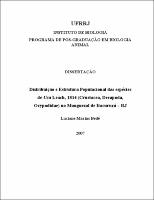Please use this identifier to cite or link to this item:
https://rima.ufrrj.br/jspui/handle/20.500.14407/10860| Tipo do documento: | Dissertação |
| Title: | Distribuição e estrutura populacional das espécies de Uca Leach, 1814 (Crustacea, Decapoda, Ocypodidae) no manguezal de Itacuruçá - RJ |
| Other Titles: | Distribution and population structure of Uca Leach, 1814 species (Crustacea Decapoda Ocypodidae) in the Itacuruçá`Mangrove - RJ |
| Authors: | Bedê, Luciane Marins |
| Orientador(a): | Oshiro, Lidia Miyako Yoshii |
| Keywords: | distribuição;estrutura populacional;gênero Uca;Manguezal de Itacuruçá;distribution;population structure;genus Uca;Itacuruçá`s Mangrove |
| Área(s) do CNPq: | Zoologia |
| Idioma: | por |
| Issue Date: | 28-Mar-2007 |
| Publisher: | Universidade Federal Rural do Rio de Janeiro |
| Sigla da instituição: | UFRRJ |
| Departamento: | Instituto de Ciências Biológicas e da Saúde |
| Programa: | Programa de Pós-Graduação em Biologia Animal |
| Citation: | BEDÊ, Luciane Marins. Distribuição e estrutura populacional das espécies de Uca Leach, 1814 (Crustacea, Decapoda, Ocypodidae) no manguezal de Itacuruçá - RJ. 2007. 59 f. Dissertação (Mestrado em Bologia Animal) - Instituto de Ciências Biológicas e da Saúde, Universidade Federal Rural do Rio de Janeiro, Seropédica - RJ, 2007. |
| Abstract: | Este trabalho foi realizado no Manguezal de Itacuruçá, na Baía de Sepetiba com o objetivo de analisar a distribuição e a estrutura populacional do gênero Uca Leach, 1814. Foram realizadas coletas em cinco diferentes áreas de junho/05 a maio/06, utilizando-se a técnica de esforço por unidade de captura. Amostras do sedimento foram coletadas nas cinco áreas, para determinar o tamanho das partículas, matéria orgânica, fósforo e metais pesados. Foram obtidas oito espécies do gênero Uca, entre as quais U. victoriana, que era registrada apenas no Estado do Espírito Santo. U. rapax foi a espécie mais abundante e U. vocator a mais rara. Os resultados revelam que a distribuição das espécies está intimamente relacionada ao tipo de substrato. U. leptodactyla, U. rapax, U. vocator, U. mordax e U. uruguayensis foram encontradas principalmente em regiões arenosas e com pouca matéria orgânica. U. thayeri, U. cumulanta e U. victoriana foram mais freqüentes em áreas lamosas com alta concentração de matéria orgânica. U. rapax e U. leptodactyla foram as espécies mais versáteis em formas de colonizar ambientes. Um total de 2580 animais foi coletado, sendo 1465 machos e 1100 fêmeas não ovígeras. Apenas 15 fêmeas ovígeras foram amostradas durante o período de estudo. Com relação ao tamanho dos indivíduos, observou-se que os animais do Manguezal de Itacuruçá, de maneira geral, apresentam tamanhos menores que os encontrados em outros manguezais do Brasil. Contudo, os machos atingiram tamanhos maiores que as fêmeas. A distribuição de freqüência em classes de tamanho foi unimodal para a maioria das espécies, com exceção apenas de U. thayeri e U. vocator que não apresentaram um padrão definido. Os machos foram mais abundantes nas classes de maiores tamanhos. A razão sexual diferiu significativamente da proporção 1:1, com exceção de U. leptodactyla, estando na maioria das vezes deslocada para uma maior freqüência de machos. |
| Abstract: | This study was conducted in the Itacuruçá Mangrove, Sepetiba Bay, Rio de Janeiro, Brazil, with the objective to investigate the distribution and population structure of the Genus Uca Leach, 1814. Sampling was performed in five areas from June/05 to May/06, using the capture effort per unit. Sediment samples from all the areas were collected to determine particle size, organic matter, phosphor and heavy metal analyses. Eight species were collected, U. victoriana which were recorded only in the State of Espírito Santo; U. rapax was the more abundant species and U. vocator the rarer. The results indicated that distribution of the crabs can be explained by its relationship with the sediment thickness. U. leptodactyla, U. rapax, U. vocator, U. mordax and U. uruguayensis were collected, primarily in areas with the sand and low concentracion of organic matter. U. thayeri, U. cumulanta and U. victoriana were collected, primarily in muddy areas with high concentrations of organic matter. U. rapax and U. leptodactyla were the species which were more versatile in habitat colonization. A total of 2580 crabs were obtained of which 1465 males and 1100 were nonovigerous females. Only 15 ovigerous females were collected during the study. The size of the crabs in the Itacuruçá´s Mangrove were the smallest size than those found in other Brazilian mangroves. However, the males attained a larger size than the females. The size frequency distribution was unimodal for the majority of the species, the only exceptions being U. thayeri and U. vocator which didn t show the defined pattern. Males were most abundant in the larger size classes. The sex ratio differ significant from 1:1 propotion (male: female), with the exception of U. leptodactyla which most of the time had a higher frequency of males. |
| URI: | https://rima.ufrrj.br/jspui/handle/20.500.14407/10860 |
| Appears in Collections: | Mestrado em Biologia Animal |
Se for cadastrado no RIMA, poderá receber informações por email.
Se ainda não tem uma conta, cadastre-se aqui!
Files in This Item:
| File | Description | Size | Format | |
|---|---|---|---|---|
| 2007 - Luciane Marins Bedê.pdf | 500.56 kB | Adobe PDF |  View/Open |
Items in DSpace are protected by copyright, with all rights reserved, unless otherwise indicated.

